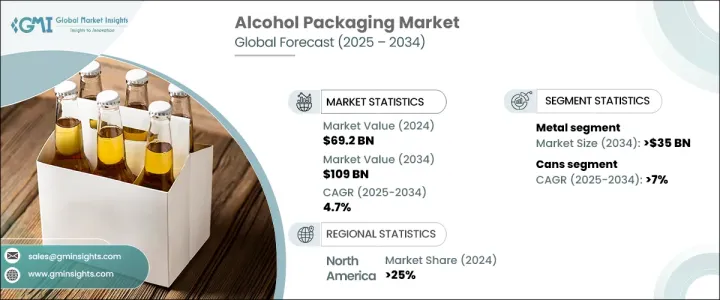
세계의 주류 포장 시장은 2024년에 692억 달러에 이르렀고, 2025년부터 2034년까지 연평균 복합 성장률(CAGR) 4.7%를 나타낼 것으로 전망됩니다.
지속가능성이 중시되는 가운데 제조업체는 이산화탄소 배출량을 줄이고 진화하는 규제기준에 대응하기 위해 포장 솔루션을 빠르게 혁신하고 있습니다. 환경 친화적인 대체품을 요구하는 움직임은 재활용, 재활용 가능 및 순환 포장 옵션의 급증으로 이어지고 있습니다. 기업은 제품의 무결성을 손상시키지 않고 폐기물을 최소화하는 소재를 선호하고 환경에 대한 책임과 소비자 만족을 모두 보장합니다.

전자상거래와 소비자에게 직접 판매하는 것은 주류 포장 산업의 형태를 지속적으로 바꾸어 가볍고 내구성이 있으며 비용 효율적인 솔루션에 대한 수요를 촉진합니다. 온라인 소매 채널이 확대되는 동안 브랜드는 물류를 간소화하면서 제품 보호를 강화하는 포장을 찾고 있습니다. 편의의 중요성은 여전히 강하고 현대적인 라이프 스타일의 선호도에 해당하는 포장 동향에 영향을 미칩니다. 소비자는 휴대성을 지원하고 음료의 신선도를 유지하며 사용하기 쉬운 옵션을 점점 선호합니다. 게다가 알코올 음료 분야의 프리미엄화 동향은 브랜드 인지를 높이는 미학적으로 매력적이고 고품질의 포장에 대한 요구를 높이고 있습니다.
| 시장 범위 | |
|---|---|
| 시작 연도 | 2024년 |
| 예측 연도 | 2025-2034년 |
| 시작 금액 | 692억 달러 |
| 예측 금액 | 1,090억 달러 |
| CAGR | 4.7% |
시장은 재료별로 유리, 금속, 플라스틱, 종이 등으로 구분됩니다. 금속 부문은 2034년까지 350억 달러를 창출할 것으로 예상됩니다. 알루미늄과 주석은 공기와 빛에 노출되는 것을 방지하는 능력에서 널리지지되며 알코올 음료의 맛과 품질을 유지하는 데 도움이 됩니다. 이 소재는 가볍고 재활용성이 높을 뿐만 아니라 환경 친화적인 선택을 요구하는 수요 증가에도 부응하고 있습니다. 내구성과 재사용성은 시장 가치를 더욱 향상시키고 폐기물을 최소화하고 지속 가능한 노력을 강화하고자 하는 브랜드에 매력적인 선택이 되고 있습니다.
시장은 또한 제품 유형별로 분류되며 병, 캔, 가방, 케그 등이 있습니다. 캔 부문은 2025년부터 2034년까지 연평균 복합 성장률(CAGR) 7%를 나타낼 것으로 예측됩니다. 운반이 가능하고 1회분씩 포장된 것을 선호하게 됨으로써, 캔은 소비자들 사이에서 가장 중요한 선택지가 되고 있습니다. 부피가 큰 포장 형태와는 달리, 캔은 가벼운 편의성을 제공하기 때문에 휴대가 쉽고 이동 중에도 소비에 이상적입니다. 컴팩트한 디자인은 부담없는 사교의 장소에서부터 야외 이벤트까지 다양한 장면에 적합하며, 캔의 보급을 더욱 뒷받침하고 있습니다. 또한, 즉시 마실 수 있는 음료와 공예 맥주에 대한 수요가 증가함에 따라 이 형식으로의 전환이 가속화되고 있습니다. 이것은 신선도를 유지하고 사용자 경험을 향상시키는 캔의 이점을 각 브랜드가 인식하고 있기 때문입니다.
북미는 2024년 세계 주류 포장 시장의 25%를 차지했으며 미국이 지역 확대를 이끌었습니다. 지속 가능한 포장 솔루션을 강조함으로써 재활용 가능하고 환경 친화적인 소재에 대한 수요가 증가하고 있습니다. 기업은 친환경 제품을 요구하는 소비자의 기대에 부응하여 알루미늄과 유리의 대체 소재를 포장 전략에 통합하고 있습니다. 전자상거래와 직접 유통 채널의 상승은 브랜드가 운송 비용과 제품 보호를 최적화하는 가볍고 내구성있는 옵션을 요구하므로 포장 선택에 큰 영향을 미칩니다. 편의성, 지속가능성, 고급스러움을 중시하는 북미의 주류 포장 업계는 소비자의 취향의 변화와 규제의 요구에 부응하기 위해 진화를 계속하고 있습니다.
The Global Alcohol Packaging Market reached USD 69.2 billion in 2024 and is set to expand at a CAGR of 4.7% between 2025 and 2034. As sustainability takes center stage, manufacturers are rapidly innovating packaging solutions to reduce carbon footprints and align with evolving regulatory standards. The push for eco-friendly alternatives has led to a surge in returnable, recyclable, and circular packaging options. Companies are prioritizing materials that minimize waste without compromising product integrity, ensuring both environmental responsibility and consumer satisfaction.

E-commerce and direct-to-consumer sales continue to reshape the alcohol packaging industry, driving demand for lightweight, durable, and cost-effective solutions. With online retail channels expanding, brands seek packaging that enhances product protection while streamlining logistics. The emphasis on convenience remains strong, influencing packaging trends that cater to modern lifestyle preferences. Consumers increasingly prefer options that support portability, maintain beverage freshness, and provide ease of use. Additionally, premiumization trends in the alcoholic beverage sector have heightened the need for aesthetically appealing and high-quality packaging that elevates brand perception.
| Market Scope | |
|---|---|
| Start Year | 2024 |
| Forecast Year | 2025-2034 |
| Start Value | $69.2 Billion |
| Forecast Value | $ 109 Billion |
| CAGR | 4.7% |
The market is segmented by material into glass, metal, plastic, paper, and others. The metal segment is expected to generate USD 35 billion by 2034, benefiting from its strong market appeal. Aluminum and tin, widely favored for their ability to prevent exposure to air and light, help preserve the taste and quality of alcoholic beverages. These materials are not only lightweight and highly recyclable but also meet the growing demand for environmentally responsible choices. Durability and reusability further enhance their market value, making them an attractive option for brands looking to minimize waste and enhance sustainability efforts.
The market is further classified by product type, including bottles, cans, bag-in-box, kegs, and others. The cans segment is projected to grow at a CAGR of 7% between 2025 and 2034. The rising preference for portable and single-serve packaging has positioned cans as a top choice among consumers. Unlike bulkier packaging formats, cans offer lightweight convenience, making them easy to transport and ideal for on-the-go consumption. Their compact design suits various occasions, from casual social gatherings to outdoor events, further driving their adoption. Additionally, the growing demand for ready-to-drink beverages and craft beer has accelerated the shift toward this format, as brands recognize the benefits of cans in maintaining freshness and enhancing user experience.
North America accounted for a 25% share of the global alcohol packaging market in 2024, with the United States leading the regional expansion. The increasing emphasis on sustainable packaging solutions has driven demand for recyclable and environmentally friendly materials. Companies are integrating aluminum and glass alternatives into their packaging strategies, responding to consumer expectations for eco-conscious products. The rise of e-commerce and direct distribution channels significantly influences packaging choices as brands seek lightweight and durable options that optimize shipping costs and product protection. With a strong focus on convenience, sustainability, and premium appeal, the alcohol packaging industry across North America continues to evolve to meet shifting consumer preferences and regulatory demands.